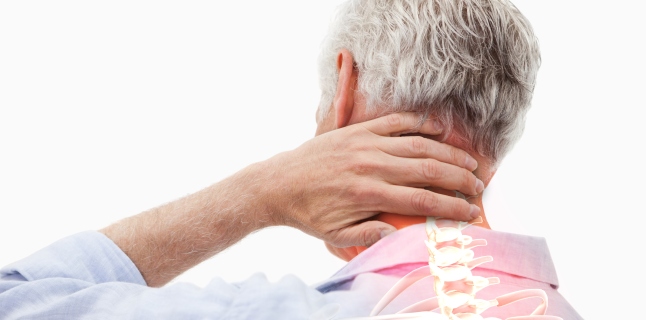Remedies for alleviating the discomfort caused by cervical spondylosis

Cervical spondylosis, recognized in medical terms and as cervical osteoarthritis, is a disorder that manifests in the cervical spine by affecting vertebral bodies and intervertebral discs at the neck and spinal canal wear, namely nerves and spinal cord. As the water content of the intervertebral discs decreases, they become jagged, the pressure increases and the cartilage that protects them deteriorates, showing the pain and the various complications. Who can be affected by cervical spondylosis? Cervical spondylosis is a disease that develops with age, with people over 60 being the most prone. It is well known that aging involves tissue dehydration, which directly affects cartilage, but there are a number of external risk factors. In this category there are neck injuries and cervical spine traumas, evolved arthritis, physical overload, or, on the contrary, sedentary. Also, obesity and osteoporosis are diseases that can directly affect the cervical area.
On the other hand, it has been shown that people who consistently adopt a wrong body position are more prone to cervical spondylosis. Studies have also highlighted a genetic component, so if a family member faced this condition, his followers are more likely to develop later. What are the symptoms of cervical spondylosis? There are cases in which, at least in the first stages, cervical spondylosis causes no symptoms and can only be detected with special medical examinations, eg X-rays. However, when these manifestations occur they can be very tedious and painful. Signs of cervical spondylosis are the constant head and neck aches that radiate to the shoulders, where the neck tends to become stiff and cause pain in motion, a pain that can be felt to the level of the arms and fingers.
This symptom is caused by the dropped pressure on a nerve that leaves the spine to the rest of the body. If there is cervical radiculopathy, ie numbness or weakness of the arms, a specialist doctor should be consulted, as it may be a first symptom attesting the installation of cervical spondylosis. On the other hand, if spinal cord or nerve root is affected, tingling and numbness may occur throughout the body, difficulty walking, and in severe situations, lack of control of the bladder and intestinal tract. Exercise for spondylosis Cervical hypoplasia can be resolved by specific therapeutic exercises to stretch and strengthen the muscles of the neck and shoulders and thus to increase the spaces between the intervertebral discs and reduce the pressure. Also, the constant relaxation of the neck muscles through specific exercises can not only prevent the appearance of cervical spondylosis but also combat pains already installed.
Exercises are mild and involve turning the neck in the side, bending the head in front and leaning back, lifting and dropping the shoulders, turning the shoulders with the hands in the hips, lifting the knee to the chest and approaching the forehead. Another important aspect in preventing and improving cervical spondylosis is the posture of the body. It is recommended to keep the right backbone in a natural position, whether sitting or walking. Sudden movements are contraindicated and at least one person experiencing back or neck pain should sleep on a hard bed in a lying position on the back and without a pillow. Natural solutions for spondylosis Treatment of cervical spondylosis depends on patient to patient and may involve, depending on the severity of the symptoms, analgesics, anti-inflammatory or supplements for muscle relaxation.
Also, calming ointments are extremely important in alleviating local pain and relieving mobility. Food supplements based on valerian, passiflora, arnica or lavender can effectively contribute to the relaxation of the whole organism. At the same time, one is the herbal-based anti-inflammatory herbal remedy, the white turmeric, black pepper extract, Boswellia extract, a plant called \. On the other hand, a real help in relieving the pains created by cervical spondylosis is the alternative application of warm and cold compresses on the affected area. .
Source : sfatulmedicului.ro
Views : 3151
Popular Article
- (photo) Nude becomes art.
Posted: 2018-03-17, 9810 views.
- The harmful effects of air conditioning on the skin
Posted: 2017-06-08, 8519 views.
- 3 causes of dyed hair discoloration
Posted: 2017-06-15, 8403 views.
- Why early puberty occurs in girls: symptoms, favors, diagnosis and treatment
Posted: 2017-10-24, 8243 views.
- Good or bad skin treatments in the hot season
Posted: 2017-06-07, 7975 views.
Recommendations
- (photo) Nude becomes art.
Posted: 2018-03-17, 9810 views.
- The harmful effects of air conditioning on the skin
Posted: 2017-06-08, 8519 views.
- 3 causes of dyed hair discoloration
Posted: 2017-06-15, 8403 views.
- Good or bad skin treatments in the hot season
Posted: 2017-06-07, 7975 views.
- Risks of practicing sports on hot days
Posted: 2017-06-12, 7549 views.
 4 effective ingredients in the fight against acne.
4 effective ingredients in the fight against acne. How to get rid of hiccups fast
How to get rid of hiccups fast The wheat bran diet: the secret of lost pounds as if by magic
The wheat bran diet: the secret of lost pounds as if by magic The recipe that will sweeten your soul this weekend!
The recipe that will sweeten your soul this weekend!  Is it dangerous or not to refreeze meat after thawing it?
Is it dangerous or not to refreeze meat after thawing it?  The unusual sign of diabetes indicated by saliva.
The unusual sign of diabetes indicated by saliva. What to drink to boost your immune system.
What to drink to boost your immune system. 10 foods that help you never age.
10 foods that help you never age. What actually happens in your body if you drink a cup of coffee for breakfast
What actually happens in your body if you drink a cup of coffee for breakfast 5 surprising benefits of chia seeds
5 surprising benefits of chia seeds